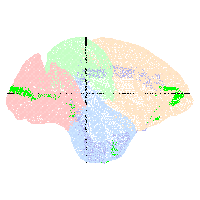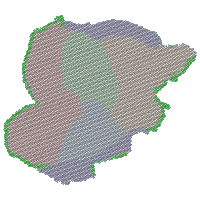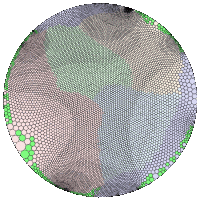NeuroImage 9, Number 6, 1999, Part 2 of 2 Parts
METHODS, PHYSIOLOGY, COGNITION
CirclePack: Software for Creating Quasi-Conformal Flat Maps
of the Brain
Monica K. Hurdal ,
De Witt L. Sumners
,
De Witt L. Sumners ,
Ken Stephenson
,
Ken Stephenson ,
Philip L. Bowers
,
Philip L. Bowers ,
,
David A. Rottenberg

 Department of Mathematics, Florida State Univeristy, Tallahassee, U.S.A.
Department of Mathematics, Florida State Univeristy, Tallahassee, U.S.A.
 Department of Mathematics, University of Tennessee, Knoxville, U.S.A.
Department of Mathematics, University of Tennessee, Knoxville, U.S.A.
 PET Imaging Center, VA Medical Center, Minneapolis, U.S.A.
PET Imaging Center, VA Medical Center, Minneapolis, U.S.A.
 Department of Radiology, University of Minnesota, Minneapolis, U.S.A.
Department of Radiology, University of Minnesota, Minneapolis, U.S.A.
Abstract
Flat maps of the cortical surface serve as a visualization
tool that can enhance the informational content of anatomical and functional
neuroimages by revealing spatial relationships that were not previously
apparent and by facilitating comparisons between individuals and groups of
subjects. We will demonstrate software which can be used to create cortical
flat maps that exhibit conformal behavior.
Methods
Although cortical flat maps can be created in many
different ways, it is usually desirable to reduce areal or angular distortion.
We use the analytic technique of circle packing (1, 2) to create a flat map of
the cerebral cortical surface which is conformal in character; by definition,
angular proportion and direction are preserved in a conformal map. The
approach is demonstrated using triangulated macaque (3) and human cortical
surfaces and CirclePack software, which runs on Linux, Sun or Solaris
workstations.
Results and Conclusions
Our approach for creating a
quasi-conformal flat map of the brain offers several advantages over other
flat mapping techniques: computation time is minimal (minutes), the mapping
is conformal in character (angular distortion is controlled), cuts in the
cortical surface are not required, and the resultant maps can be displayed
in the hyperbolic plane as well as in the conventional Euclidean plane. The
origin of flat maps in the hyperbolic plane can be interactively transformed,
so that different anatomical landmarks can be brought to the map focus and
distortion relegated to the periphery; moreover, map transformations can be
accomplished in real time. As with other flat maps, color can be used to
identify anatomical features. Although CirclePack software is still under
development, it promises to be a valuable new tool for the visualization and
analysis of PET and fMRI functional activation data.
 |
 |
 |
| Reconstruction of Macaque Cortex (3) |
Euclidean Flat Map |
Hyperbolic Flat Map |
1. Dubejko, T., Stephenson, K., Experimental Mathematics, 1995, 4:307-348.
2. Hurdal, M. K., Sumners, D. W. L., Stephenson, K., Bowers, P. L.,
Rottenberg, D. A., "Generating Conformal Flat Maps of the Cortical Surface
via Circle Packing", Abstract submitted to 5th International Conference on
Functional Mapping of the Human Brain (HBM99), 1999.
3. Drury, H. A., Van Essen, D. C., Anderson, C. H., Lee, C. W.,
Coogan, T. A., Lewis, J. W., 1996, J. Cog. Neurosci.,
8:1-28.
Acknowledgments
The authors would like to gratefully
acknowledge Heather Drury and David Van Essen from Washington University
Medical School, St. Louis, for their kind assistance in providing some of
the data used in this demonstration.
This work is supported in part
by NIH grants MH57180 and NS33718.
S250
 ,
De Witt L. Sumners
,
De Witt L. Sumners ,
Ken Stephenson
,
Ken Stephenson ,
Philip L. Bowers
,
Philip L. Bowers ,
,

 Department of Mathematics, Florida State Univeristy, Tallahassee, U.S.A.
Department of Mathematics, Florida State Univeristy, Tallahassee, U.S.A.
 Department of Mathematics, University of Tennessee, Knoxville, U.S.A.
Department of Mathematics, University of Tennessee, Knoxville, U.S.A.
 PET Imaging Center, VA Medical Center, Minneapolis, U.S.A.
PET Imaging Center, VA Medical Center, Minneapolis, U.S.A.
 Department of Radiology, University of Minnesota, Minneapolis, U.S.A.
Department of Radiology, University of Minnesota, Minneapolis, U.S.A.

